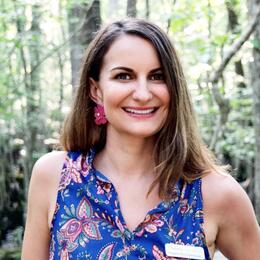CHARLESTON, South Carolina—Audubon South Carolina is pleased to announce the installation of 215,000 native hardwood tree seedlings at its Audubon Center and Sanctuary at Beidler Forest, an initiative that will restore the bottomland hardwood forest ecosystem that once stood there while restoring habitat, improving flood control and increasing carbon storage.
“Audubon has been protecting and restoring habitat for 50 years in South Carolina. Our mission is to protect birds and the habitats they need, now and in the future. While we are facing immediate development pressures, we know that restoring our native landscapes and floodplain forests are a critical investment in the future of our watershed and our communities,” said Sharon Richardson, executive director of Audubon South Carolina. “We witnessed the incredible volume of flood water that our swamps stored for months following the devastation of the September 2015 flooding. We are proactively working to restore the hydrology and forest communities, which will in turn improve the public benefits our watershed provides to downstream.”
In mid-February, teams of workers planted just under 500 acres of the 18,000-acre Sanctuary over the course of three days, using Bald Cypress, Green Ash, Water Oak, Laurel Oak, Swamp Chestnut Oak, and Water Tupelo seedlings supplied by South Carolina’s own ArborGen. In 30 to 50 years, the growth of these hardwood species will produce a bottomland hardwood forest and denote a landscape more than 200 years old. With Bald Cypress storing carbon at a higher rate than other native trees, Audubon is promoting sequestration as a market driven solution. Audubon operates an Improved Forest Management Carbon Sequestration Bank on another portion of their holdings in Four Holes Swamp.
Although the seedlings will mature at a slower rate than the pine that was replaced, over time, they will store significant amounts of carbon. Their new, deep-spreading root systems will restore the property’s hydrology, greatly benefit the watershed and its function by absorbing storm water, reducing flooding and erosion and naturally recharge the groundwater, while serving as a giant water filter and improving water quality for downstream communities.
“Audubon’s approach to commonsense, win-win solutions to the very serious weather-related issues facing our state, are exactly the type of demonstration sites the Governor McMaster is expecting to highlight with the Floodwater Commission,” said Chairman Tom Mullikin. “The use of landscape scale green infrastructure approaches that protect, restore and mimic natural systems not only protects against the worst effects of flooding, but it also provides rich and productive habitat for our wildlife.”
Previously, the degraded portion of Beidler was home to densely planted loblolly and slash pine atop berms, or raised banks, with miles of drainage ditches in between. Intended to improve the growing environment for the pine trees, this unnatural infrastructure resulted in storm water rushing off the land and taking sediment with it, while preventing the rain from permeating the ground and recharging the aquifer as an untouched forest or wetland would.
Before they were harvested for timber, cleared for agriculture, or replanted in pine plantations, bottomland hardwood forests were once much more common in South Carolina. The native hardwood trees not only create some of the best breeding habitat for a suite of forest-interior, migratory, neotropical birds, but they support enormous amounts of native insects and caterpillars that 96 percent of all land birds require to feed their young.
Now at less than 85 percent of historic coverage, the substantial reduction in bottomland hardwood forest habitat has been linked to a reduction of those bird species that heavily depend on them, such as the Wood Thrush and Swallow-tailed Kites.
After the planting, the habitat will begin to attract bird species that will take advantage of its progressive stages when it’s most beneficial for them. For instance, early successional bird species will thrive as the seedlings first begin to grow, such as Yellow-breasted Chats, Indigo Buntings, Blue Grosbeaks, Sedge Wrens, Northern Harriers, Woodcocks, and Wild Turkeys. When the site matures into a young forest, we expect more forest dwelling species, such as Hooded Warblers, Swainson’s Warblers, and Gray Catbirds. Eventually, the mature forest will draw Northern Parulas, Wood Thrush, Yellow-billed Cuckoos, Vireos, Swallow-tailed Kites, and hopefully Prothonotary Warblers.
“ArborGen provides landowners with seedlings to grow both beautiful, profitable forests and for protecting and providing habitat for birds,” details Andrew Baum, Chief Executive Officer of ArborGen. “Audubon understands the two goals are mutually supportive. As their neighbor, we are happy to help them as they continue to create habitat for birds here in South Carolina.”
Audubon South Carolina strives to restore forests and wetlands to create healthier watersheds, carbon storage, and critical bird habitat. To this date Audubon South Carolina owns and manages 22,000 acres across the state and works with many partners to restore other properties as well.
About Audubon South Carolina
Audubon South Carolina protects birds and the places they need, right here in South Carolina. We’re the state office of the National Audubon Society, which has more than one million members and a century-long track record of success. In South Carolina, we represent more than 20,000 Audubon members and supporters, nine Audubon chapters and bird club partners, two Audubon centers and 22,000 acres of land that we own and manage. Learn more about what we do and how to help at sc.audubon.org. Follow us on Facebook at @ScAudubon, Twitter at @AudubonSc, and Instagram at @audubon_sc.
About National Audubon Society
The National Audubon Society protects birds and the places they need, today and tomorrow, throughout the Americas using science, advocacy, education and on-the-ground conservation. Audubon’s state programs, nature centers, chapters and partners have an unparalleled wingspan that reaches millions of people each year to inform, inspire and unite diverse communities in conservation action. Since 1905, Audubon’s vision has been a world in which people and wildlife thrive. Audubon is a nonprofit conservation organization. Learn more at www.audubon.org and @audubonsociety.
Media Contact
Sarah McKenna
Communications Associate
smckenna@audubon.org
(561) 632-8457




